|
Réponse |
Message 1 de 50 de ce thème |
|
Philosophy
Philosophy can be defined as: “ 1 the use of reason and argument in seeking knowledge and truth of reality, esp. of the causes and nature of things and of the principles governing existence, the material universe, perception of physical phenomena, and human behavior. 2 a a particular system or set of beliefs reached by this. b a personal rule of life. 3 advanced learning in general (doctor of philosophy). 4 serenity; calmness; conduct governed by a particular philosophy. [philosophia wisdom (as PHILO-, sophos wise)]” [1]
It is noteworthy that “philo-” is a combining form “denoting a liking for what is specified,” such that “philosophy” becomes the love of wisdom. This is very distinct from seeking truth and knowledge. Wisdom far exceeds both knowledge and truth. It is the use of such tools, “experience and knowledge together with the power of applying them critically or practically.” Wisdom is perception, perceptiveness, percipience, perspicuity, perspicacity, and prudence. (As in The Tao of Pooh.) It could even be thought of as enlightenment.
In addition to wisdom, “sophy” (from Sophia, the Goddess of Wisdom) can be thought of as “the study, knowledge, and wisdom of...”. If we further break down “philo” to “phi” and “lo” -- and “lo” means “the amazing sight” (as in “lo and behold”), then philosophy also means, “the study, knowledge, and wisdom of the amazing sight of... phi.” Meanwhile, phi is the Greek letter which is used to denote the Golden Mean, a ratio or number which equals 0.618033987... (or 1.618033987... -- the two numbers being interchangeable).
Philosophy as per our first set of definitions (which covers really a lot of ground), and even as a love of wisdom (in its highest connotations), can simultaneously be thought of as the study, knowledge, and wisdom of a numerical ratio! This latter fact is evidence of the vast importance of Sacred Mathematics as an integral part of philosophy.
Now, which would you rather study? All the machinations and bewildering thoughts of mentally rearranged minds like Nietsche (who advocated the concept of the Superman, an idea which Nazi Germany took to an extreme), Peanuts (as in The Gospel According to...), Decartes (“I think, therefore I am”), Bush (“I don’t think, therefore I am President”), Spinoza, and so forth and so on? Or would you prefer the logic, purity, and inherent predictability of mathematics, a field without the bias of interpretation?
Whichever you choose, it is wise (i.e. the use of wisdom, perspicacity, etceteras) to remember that when Rene Decartes, the French philosopher, died, the funeral bier on which his body was taken to the cemetery was pushed by a horse, instead of being drawn in the traditional way. This was the first example of “putting Decartes before de horse.” Now, dis is philosophy!
Xenophobia is often thought of as ‘fear of strangers’, but is more likely, “an abnormal or morbid fear or aversion” (phobia) of anything “strange, foreign, or stranger” (xeno) Xenophobia is thus contrary to philosophy, wherein wisdom requires a xenocuriosity. Which is the basis for this extended website -- in case you were wondering.
But consider the case of strangers in our midst. Evan Hodkins has noted that “Philoxenia is the Greek word for hospitality. The literal meaning is ‘love of strangers’.” But enlarge this concept of stranger to include any strange or foreign event. Even then, “A stranger is different from both enemy and friend. The stranger is an emissary from the unknown, the placeholder of surprise, the instrument of Divine interruption, the speaker of stunning revelations. Foreigners come to us from beyond the borders and boundaries of our insularity and deliver new perspectives.” [2]
“When relationships of destiny insinuate themselves, we call it b’shert in Hebrew, kismet in Arabic.” It’s the orchestration of apparent chance encounters, where we suddenly find in an event or another person the delights of an “ancient belonging.”
Thus true philosophy can be viewed as the strange, the unknown, the foreign, all being things to be welcomed. Even adversities. For they bring their own form of gifts, and with an increasing wisdom, an ever expanding love of wisdom, our philosophy will always find an honored place in our home for all such emissaries from beyond.
At the same time, it must be remembered that a society which honors philosophers and does not honor plumbers will have neither philosophies nor plumbing which hold water.
|
|
|
|
Réponse |
Message 21 de 50 de ce thème |
|
FI=PHI=NUMERO DE ORO=1.618033
171. Salmos 45:9: Hijas de reyes están entre tus ilustres; Está la REINA a tu diestra con oro de Ofir.
SO-FI-A/SABIDURIA/S-OFI-A/FI-L-OFI-A
REINA VESTIDA CON ORO DE O-FI-R
201. Romanos 11:33: ¡Oh profundidad de las riquezas de la sabiduría y de la ciencia de Dios! ¡Cuán insondables son sus juicios, e inescrutables sus caminos!
| Rom 11:33 O the depth of the riches both of the wisdom and knowledge of God! how unsearchable are his judgments, and his ways past finding out! |
|
|
|
|
|
σοφια sophia {sof-ee'-ah} from 4680; TDNT - 7:465,1056; n f AV - wisdom 51; 51 1) wisdom, broad and full of intelligence; used of the knowledge of very diverse matters 1a) the wisdom which belongs to men 1a1) spec. the varied knowledge of things human and divine, acquired by acuteness and experience, and summed up in maxims and proverbs 1a2) the science and learning 1a3) the act of interpreting dreams and always giving the sagest advice 1a4) the intelligence evinced in discovering the meaning of some mysterious number or vision 1a5) skill in the management of affairs 1a6) devout and proper prudence in intercourse with men not disciples of Christ, skill and discretion in imparting Christian truth 1a7) the knowledge and practice of the requisites for godly and upright living 1b) supreme intelligence, such as belongs to God 1b1) to Christ 1b2) the wisdom of God as evinced in forming and executing counsels in the formation and government of the world and the scriptures For Synonyms see entry 5826
Gematria: 781
SO-PHI-A
|
|
|
|
Réponse |
Message 22 de 50 de ce thème |
|

FI=PHI=NUMERO DE ORO=1.618033
171. Salmos 45:9: Hijas de reyes están entre tus ilustres; Está la REINA a tu diestra con oro de Ofir.
SO-FI-A/SABIDURIA/S-OFI-A/FI-L-OFI-A
REINA VESTIDA CON ORO DE O-FI-R
201. Romanos 11:33: ¡Oh profundidad de las riquezas de la sabiduría y de la ciencia de Dios! ¡Cuán insondables son sus juicios, e inescrutables sus caminos!
| Rom 11:33 O the depth of the riches both of the wisdom and knowledge of God! how unsearchable are his judgments, and his ways past finding out! |
|
|
|
|
|
σοφια sophia {sof-ee'-ah} from 4680; TDNT - 7:465,1056; n f AV - wisdom 51; 51 1) wisdom, broad and full of intelligence; used of the knowledge of very diverse matters 1a) the wisdom which belongs to men 1a1) spec. the varied knowledge of things human and divine, acquired by acuteness and experience, and summed up in maxims and proverbs 1a2) the science and learning 1a3) the act of interpreting dreams and always giving the sagest advice 1a4) the intelligence evinced in discovering the meaning of some mysterious number or vision 1a5) skill in the management of affairs 1a6) devout and proper prudence in intercourse with men not disciples of Christ, skill and discretion in imparting Christian truth 1a7) the knowledge and practice of the requisites for godly and upright living 1b) supreme intelligence, such as belongs to God 1b1) to Christ 1b2) the wisdom of God as evinced in forming and executing counsels in the formation and government of the world and the scriptures For Synonyms see entry 5826
Gematria: 781
SO-PHI-A
 
MATEO 16:18 (NUMERO DE ORO=PHI)
THE GOLDEN SECRET
16:18 Y yo también te digo, que tú eres Pedro, y sobre esta roca edificaré mi iglesia; y las puertas del Hades no prevalecerán contra ella. (NUMERO DE ORO) (MARIA MAGDALENA SIMBOLIZA A LA IGLESIA/NUEVA JERUSALEM. AQUI NUESTRO SEÑOR INDUDABLEMENTE BUSCA UN NEXO ESOTERICO CON SU ESPOSA Y EL GRIAL-S-OPHI-A/SABIDURIA-ONE EN EL BILLETE DE UN DOLAR ES UN ANAGRAMA DE NOE)
El Número de Oro; Phi; la Divina Proporción
16:19 Y a ti te daré las llaves del reino de los cielos; y todo lo que atares en la tierra será atado en los cielos; y todo lo que desatares en la tierra será desatado en los cielos.
|
|
|
|
Réponse |
Message 23 de 50 de ce thème |
|
|
|
|
Réponse |
Message 24 de 50 de ce thème |
|
EL 19 DE ABRIL ES EL PRIMER DIA DEL AÑO LUNI-SOLAR HEBREO. EN 1810 FUE LA REVOLUCION DE MAYO EN ARGENTINA E INCLUSO FUE LA INDEPENDENCIA DE COLOMBIA (20 DE JULIO), EL MISMO DIA DE LA LLEGADA A LA LUNA. EL 15 DE AGOSTO, DIA DE LA ASUNCION DE LA VIRGEN, FUE EL DIA NUMERO 119. ¿MUCHA CASUALIDAD NO?
Fases Lunares para el mes de Abril del año 1810
Fases Lunares para el mes de Agosto del año 1810
En el calendario lunar se calculan los años según los ciclos de la luna en lugar de los del sol como se hace en el calendario occidental. En dicho calendario lunar, cada mes lunar corresponde a una lunación, que comprende el período entre dos momentos en que la luna se halla exactamente en la misma fase lunar. Cada mes lunar comprende 29.53 días solares.
Aunque cada día del mes lunar correspondería a una fase lunar, las fases de la luna a las que se conoce con un nombre concreto son la Luna Nueva, Cuarto Creciente, Luna Llena y Cuarto Menguante. Estas fases lunares se asocian a diferentes porcentajes de iluminación o ángulos de fase que van del 0% en la luna nueva, 50% en los cuartos y 100% en la luna llena.
| Día | Fase lunar | Porcentaje iluminado |
| 29 |
Luna Nueva |
En la fase lunar de Luna Nueva la visibilidad es del 0% |
| 7 |
Cuarto Creciente |
En la fase lunar de Cuarto Creciente la visibilidad es del 50% |
| 15 |
Luna Llena |
En la fase lunar de Luna Llena la visibilidad es del 100% |
| 22 |
Cuarto Menguante |
En la fase lunar de Cuarto Menguante la visibilidad es del 50% |
|
|
|
|
Réponse |
Message 25 de 50 de ce thème |
|
FI=PHI=NUMERO DE ORO=1.618033
171. Salmos 45:9: Hijas de reyes están entre tus ilustres; Está la REINA a tu diestra con oro de Ofir.
SO-FI-A/SABIDURIA/S-OFI-A/FI-L-OFI-A
REINA VESTIDA CON ORO DE O-FI-R
SOFIA/SABIDURIA/SABADO
|
|
|
|
Réponse |
Message 26 de 50 de ce thème |
|
Magdalene by the Gnostics has been named Venus
As they turn, the planets are showing us the mysterious workings of God's hand, expressed in the harmonious movements of the spheres. Each planet, as it revolves in its orbit, reaches positions where Earth, Sun and Planet form distinct alignment patterns. Only one planet shows us a perfect geometrical form. This form is pentagonal and the planet is Venus. Creating five equally-spaced alignments over a period of eight years, she draws the perfect, hidden and secret symbol of the five-pointed star in the heavens. As above, so below. The very landscape bears the sign of her secret revelation.
—Key To The Sacred Pattern by Henry Lincoln
|
|
|
|
Réponse |
Message 27 de 50 de ce thème |
|
Al igual que vimos el pasado día con el arquitecto español, dan un repaso a los increibles conocimientos matemáticos que tenían los constructores originales de las pirámides…
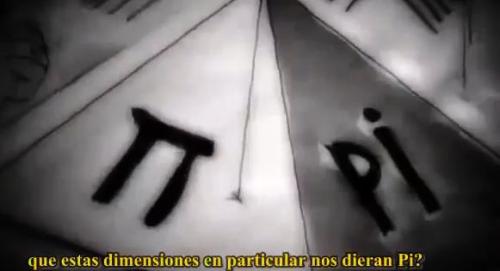
24-05-12 La Vanguardia entrevista al arquitecto español Miquel Pérez-Sánchez: "La pirámide de Keops conmemora el diluvio universal"…Avanzadísimas matemáticas se esconden en las medidas de la pirámide!!
También nos explican porque los constructores de las pirámides eligieron una medida tan aparentemente irregular que era el "codo"… 0,5235 metros…
Y el porque utilizaron esa extraña medida es tan sencillo, cómo dividir el diámetro de una circunferencia de 1 metro, pi entre 6…3,1416 / 6 = 0,5236…
O también…

Y todo medido en METROS!!!
Y la altura?? Sencillo, basandonos en geometría…
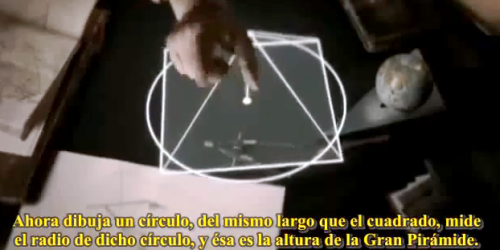
Pero no nos olvidemos que la altura de la pirámide es de 147 metros…
y la distancia al Sol en el perihelio es poco más de 147 millones de kilómetros
Es decir, calcularon la base para que la altura fuera esa…y cómo sabían la distancia que había al sol en sistema métrico??
Pero que dicen los matemáticos sobre la probabilidad de que fuese todo una casualidad ?…de que no conociesen ni el metro ni Pi, ni Phi?…PRACTICAMENTE NULA!!!!
ESTO ES CIENCIA, y durante años hemos sido catalogados como pseudocientíficos…Manda narices!

Y otro tema que ya alguno se estará preguntando…cómo conocían el metro si está basado en una medición de la CIRCUNFERENCIA DE LA TIERRA????????
Concretamente…
METRO = la diezmillonésima parte de la distancia que separa el polo de la línea del ecuador terrestre
y esto fue definido oficialmente por primera vez en 1791..
je je…Cómo????
Que sabían que la TIERRA ERA REDONDA??? y no sólo eso, sino que conocían sus medidas????
Je je…me lo estoy pasando BOMBA!!!!
Conocimientos que han pasado desapercibidos para la GRAN MAYORÍA, salvo para la MASONERÍA…sociedades secretas…cuyos integrantes construían templos, catedrales, etc, y ya utilizaban también con anterioridad a 1793 la medida del metro……cuando en esas épocas la gran pirámide estaba todavía enterrada en la arena…de nuevo..jeje!
Y sentaos que con lo siguiente os podéis caer de espaldas!!!
Y aquí no acaba la cosa…
|
|
|
|
Réponse |
Message 28 de 50 de ce thème |
|
|
PUERTA DE TITO
STAR GATE
PUERTA DE UNA ESTRELLA/GRIAL
PUERTA DE DIOS Y CASA DEL CIELO
ESCALERA DE JACOB
CUADRATURA DEL CIRCULO
NUMERO DE ORO PHI
1.618033
ESCALERA DE JACOB
SABIDURIA/SABADO/ SOPHIA/PHI=1.618033
|
|
|
|
Réponse |
Message 29 de 50 de ce thème |
|
flor de lis/scorpion
La fleur de lis, Robert Langdon y Sophie la encuentran en el contexto a una llave detras de un cuadro de Leonardo Da Vinci (Maddona y el niño/Virgen de las Rocas) en la piramide de Louvre. La fleur de lis, tiene una forma similar al escorpion, y en la tora tiene fuerte nexo con Salomon. LA PUERTA DE ORO, tiene nexo con la CONSTELACION DE SCORPION y SAGITARIO.
LA CONSTELACION DE SCORPION ANTIGUAMENTE TENIA RELACION CON EL AGUILA. LA FLEUR DE LIS tiene fuerte relacion esoterica en el CODIGO DA VINCI e incluso cuando SOPHIE Y ROBERT LANGDON, INGRESAN LA CLAVE QUE ES LA SERIE DE PHIBONACCI en un BANCO, LO HACEN CON UNA LLAVE CON LA FORMA DE LA FLEUR DE LIS. ¿CASUALIDAD O CAUSALIDAD QUE LAS CRISIS ECONOMICAS MUNDIALES SON TODAS EN OCTUBRE? HAY UN OBVIO NEXO CON EL ESCORPION. EN LA ERA DE ACUARIO, EL SOLSTICIO DE INVIERNO ES EN LA CONSTELACION DE SCORPION.
|
|
|
|
Réponse |
Message 30 de 50 de ce thème |
|
Louvre Pyramid
From Wikipedia, the free encyclopedia
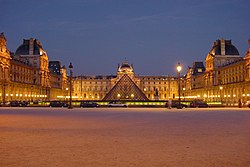
The Pyramid surrounded by the adjacent wings of the Louvre
The Louvre Pyramid (Pyramide du Louvre) is a large glass and metal pyramid, surrounded by three smaller pyramids, in the main courtyard (Cour Napoléon) of the Louvre Palace (Palais du Louvre) in Paris. The large pyramid serves as the main entrance to the Louvre Museum. Completed in 1989,[1] it has become a landmark of the city of Paris.
[edit] Design and construction

Inside the Pyramid:the view of the Louvre Museum in Paris from the underground lobby of the Pyramid.
Commissioned by the President of France François Mitterrand in 1984, it was designed by the architect I. M. Pei, who is responsible for the design of the Miho Museum in Japan, and Place Ville-Marie in Montreal, and the National Gallery of Art (East Building) in Washington, D.C. among others. The structure, which was constructed entirely with glass segments, reaches a height of 20.6 metres (about 70 feet); its square base has sides of 35 metres (115 ft). It consists of 603 rhombus-shaped and 70 triangular glass segments.[2]
The pyramid structure was engineered by Nicolet Chartrand Knoll Ltd. of Montreal (Pyramid structure / Design Consultant) and Rice Francis Ritchie (also known as RFR) of Paris (Pyramid Structure / Construction Phase).[3]
The pyramid and the underground lobby beneath it were created because of a series of problems with the Louvre's original main entrance, which could no longer handle the enormous number of visitors on an everyday basis. Visitors entering through the pyramid descend into the spacious lobby then re-ascend into the main Louvre buildings.
For design historian Mark Pimlott, "I.M. Pei’s plan distributes people effectively from the central concourse to myriad destinations within its vast subterranean network... the architectonic framework evokes, at gigantic scale, an ancient atrium of a Pompeiian villa; the treatment of the opening above, with its tracery of engineered castings and cables, evokes the atria of corporate office buildings; the busy movement of people from all directions suggests the concourses of rail termini or international airports."[4]
Several other museums have duplicated this concept, most notably the Museum of Science and Industry in Chicago. The Dolphin Centre, featuring a similar pyramid, was opened in April 1982, by Prince Richard, Duke of Gloucester.[5] The construction work on the pyramid base and underground lobby was carried out by the Vinci construction company.[6]

The large glass pyramids seen at night

The large glass pyramids seen by day
[edit] Controversy

Maintenance of the Louvre Pyramid

The entry lobby of the Louvre museum beneath the pyramid (taken with a Fisheye lens Nikkor 8mm)
The construction of the pyramid triggered considerable controversy because many people felt that the futuristic edifice looked quite out of place in front of the Louvre Museum with its classical architecture. Certain detractors ascribed a "Pharaonic complex" to Mitterrand. Others lauded the juxtaposition of contrasting architectural styles as a successful merger of the old and the new, the classical and the ultra-modern.
The main pyramid is actually the largest of several glass pyramids that were constructed near the museum, including the downward-pointing La Pyramide Inversée that functions as a skylight in an underground mall in front of the museum. During the design phase, there was a proposal that the design include a spire on the pyramid to simplify window washing. This proposal was eliminated because of objections from I. M. Pei.[citation needed]
[edit] Urban legend of 666 panes
It has been claimed by some that the glass panes in the Louvre Pyramid number exactly 666, "the number of the beast", often associated with Satan. Dominique Stezepfandt's book François Mitterrand, Grand Architecte de l'Univers declares that "the pyramid is dedicated to a power described as the Beast in the Book of Revelation (...) The entire structure is based on the number 6."
The story of the 666 panes originated in the 1980s, when the official brochure published during construction did indeed cite this number (even twice, though a few pages earlier the total number of panes was given as 672 instead). The number 666 was also mentioned in various newspapers. The Louvre museum however states that the finished pyramid contains 673 glass panes (603 rhombi and 70 triangles).[7] A higher figure was obtained by David A. Shugarts, who reports that the pyramid contains 689 pieces of glass.[8] Shugarts obtained the figure from the offices of I. M. Pei.
Elementary math allows for easy counting of the panes: each of the three sides of the pyramid without an entrance has 18 triangular panes and 17 rows of rhombic ones arranged in a triangle, thus giving  rhombic panes (171 panes total). The side with the entrance, however, has 11 panes fewer (9 rhombic, 2 triangular), so the whole pyramid consists of rhombic panes (171 panes total). The side with the entrance, however, has 11 panes fewer (9 rhombic, 2 triangular), so the whole pyramid consists of  rhombi and rhombi and  triangles, 673 panes total. triangles, 673 panes total.
The myth resurfaced in 2003, when Dan Brown incorporated it in his best-selling novel The Da Vinci Code, in which the protagonist reflects that "this pyramid, at President Mitterrand's explicit demand, had been constructed of exactly 666 panes of glass - a bizarre request that had always been a hot topic among conspiracy buffs who claimed 666 was the number of Satan".[9] However, David A. Shugarts reports that according to a spokeswoman of the offices of I. M. Pei, the French President never specified the number of panes to be used in the pyramid. Noting how the 666 rumor circulated in some French newspapers in the mid-1980s, she commented: "If you only found those old articles and didn't do any deeper fact checking, and were extremely credulous, you might believe the 666 story".[10]
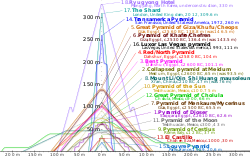
Comparison of approximate profiles of Louvre Pyramid with some notable pyramidal or near-pyramidal buildings. Dotted lines indicate original heights, where data is available.
[edit] La Pyramide Inversée
La Pyramide Inversée (The Inverted Pyramid) is a skylight in the Carrousel du Louvre shopping mall in front of the Louvre Museum. It looks like an upside-down and smaller version of the Louvre Pyramid.
http://en.wikipedia.org/wiki/Louvre_Pyramid
NUMERO 666
|
|
|
|
Réponse |
Message 31 de 50 de ce thème |
|
Squaring the Circle - The Great Pyramid
|
The square represents the physical. The circle represents the spiritual. All sacred geometers have attempted the impossible: to square the circle (create a square who's perimeter is equal to the circumference of a circle.)
Here is the first of two valiant attempts:
This squaring of the circle works with a right triangle that represents the apothem (ZY) - (a line drawn from the base of the center of one of the sides to top of the pyramid), down to the center of the base (ZE), and out to the point where the apothem touches the Earth (EY).
|
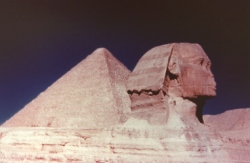
The Great Pyramid of Egypt
(Sphinx in foreground)
|
|
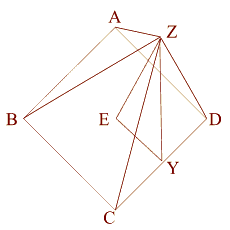
|
Now let's look at this in 2D,
from directly above.
For the purpose of this exercise,
the side (AB) of the base equals 2.
|
|
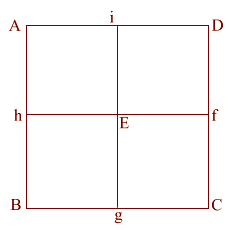
|
(ABCD) is the base of the Great Pyramid.
This is lettered similarly to the wire frame version (above).
For the purpose of this exercise,
the side (AB) of the base equals 2.
|
|

|
Construct square (i JKD),
thus creating double square (JKE f).
|
|
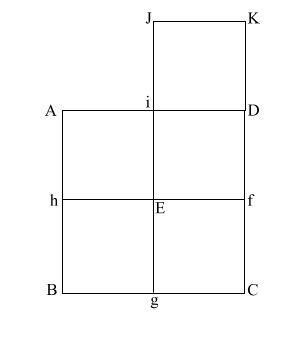
|
Create diagonal (EK)
which intersects (i D) at (l).
iD = 1,
therefore the diameter
of the circle is also 1.
(EK) = ( 5) = .618 + 1 + .618 5) = .618 + 1 + .618
|
|
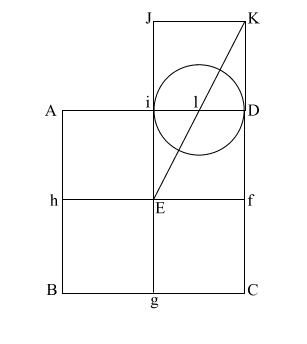
|
Put the point of your compass at (E) and extend it along the diagonal (EK) to point (m) where the circle intersects (EK), and draw the arc downward to intersect (KD f C) at (n).
If (EK) = ( 5), and (l m/l D) and l i = .5, the diameter of this circle is 1. 5), and (l m/l D) and l i = .5, the diameter of this circle is 1.
This makes (E m) = .618 + 1, or 1.618.
(E m) is the apothem.
|
|
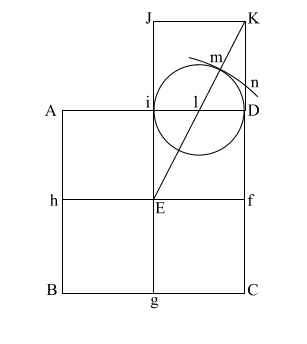
|
Draw (E n) which intersects (A i l D ) at (o).
Put compass point at (f) and extend it to (n). Again put your point at (E) and draw the circle which happens to have the radius (E o).
(f n) is the height of the Great Pyramid.
This circle comes remarkably close to having the same circumference as the perimeter of the base (ABCD).
|
|
Let's go back to the original right triangle (EYZ)
(EY) = .5
(YZ) = phi
(EZ) = ( phi) phi)
EY = .5, The apothem is phi/1.618. This makes the 51 degree + degree angle.
Using a² + b² = c², this makes the height the square root of phi.
|
Squaring the Circle - The Earth & the Moon
|
Create a square (ABCD) with (AB) = 11
Create diagonals (AC) and (BD) crossing at center point (E)
Construct a circle which is tangent to square (ABCD) at f
|
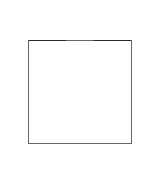
|
|
Construct two 3 . 4 . 5 right triangles, with the 4 . 5 angles at (A) and (D).
Connect the 5 . 3 angles creating square (abcd) with side (ab) = 3
{4 + 3 + 4 = 11, or side (AD) of square (ABCD)}
Create diagonals (ac) and (bd) centering at (e)
Create a circle that is tangent to square (abcd) at four places.
|
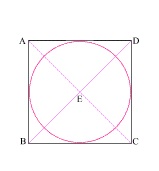
|
|
Draw line (Ee) which intersects side (AD) at (F)
(EF) = the radius of the larger circle and (eF) = the radius of the smaller circle
The larger circle thus created is to the smaller circle as the moon is to the Earth!
With your compass point at (E), create a circle with radius (Ee)
This creates a circle whose circumference is equal to the perimeter of square (ABCD)!
|

|
The Math:
|
1
(AB) = 11
(EF) = 1/2 of (AB) = 5.5
(ab) = 3
(eF) = 1.5
Therefore 5.5 + 1.5 = 7
The circumference of a circle is equal to two times the radius (the diameter) times pi (3.1416).
C= 14 x 3.1416
C= 43.9824
|
2
In Square (ABCD), (AB) = 11
The perimeter of a square is four times one side. 11 x 4 = 44
According to the Cambridge Encyclopedia, the equator radius of the Earth is 3963 miles. The equator radius of the Moon is 1080.
The claim is that the smaller circle (in square abcd) is to the larger circle (in square ABCD) as the Moon is to the Earth.
|
|
3
(EF) = 5.5
(F e) = 1.5
5.5 : 1.5 :: 3963 : 1080
5.5 / 1.5 = 3.66666
3963 / 1080 = 3.6694 - (if it had been 3960, it would have been exact!)
|
|
|
|
|
Réponse |
Message 32 de 50 de ce thème |
|
ENTRE 1792 Y 1917 (FATIMA) HAY 125 AÑOS EXACTOS
13/10/1792=PIEDRA ANGULAR DE WASHINGTON D.C
13/10/1917=ULTIMA APARICION DE LA VIRGEN DE FATIMA
(125 * 365.242256) / 29.53059 =
1546.03351982
((1917 - 1776) * 365.242256) / 29.53059 =
1743.92581035
(1746 * 29.53059) / 365.242256 =
141.167702512
(141.167702512 - 141) * 365.242256 =
61.2520438197
.618=1/1.618=1/PHI
CONCRETAMENTE entre el año de la INDEPENDENCIA DE EEUU Y EL AÑO DE la Virgen de Fatima hay una diferencia de 141 años. ¿Es casualidad que en 1746 ciclos lunares tenemos 141 años y 61 (1/phi) dias?
141=47*3
4/7=independencia EEUU
|
|
|
|
|
|
Réponse |
Message 33 de 50 de ce thème |
|
Phi in the Bible
Although perhaps not immediately obvious, phi and the golden section also appear in the Bible. Also see the Theology page.
The Ark of the Covenant is a Golden Rectangle
In Exodus 25:10, God commands Moses to build the Ark of the Covenant, in which to hold His Covenant with the Israelites, the Ten Commandments, saying,

“Have them make a chest of acacia wood-
two and a half cubits long,
a cubit and a half wide,
and a cubit and a half high.”
The ratio of 2.5 to 1.5 is 1.666…, which is as close to phi (1.618 …) as you can come with such simple numbers and is certainly not visibly different to the eye. The Ark of the Covenant is thus constructed using the Golden Section, or Divine Proportion. This ratio is also the same as 5 to 3, numbers from the Fibonacci series.
In Exodus 27:1-2, we find that the altar God commands Moses to build is based on a variation of the same 5 by 3 theme:
“Build an altar of acacia wood, three cubits high; it is to be square, five cubits long and five cubits wide.”
Note: A cubit is the measure of the forearm below the elbow.

Noah’s Ark uses a Golden Rectangle
In Genesis 6:15, God commands Noah to build an ark saying,
“And this is the fashion which thou shalt make it of: The length of the ark shall be three hundred cubits, the breadth of it fifty cubits, and the height of it thirty cubits.”
Thus the end of the ark, at 50 by 30 cubits, is also in the ratio of 5 to 3, or 1.666…, again a close approximation of phi not visibly different to the naked eye. Noah’s ark was built in the same proportion as ten arks of the covenant placed side by side.

The Number 666 is related to Phi
Revelation 13:18 says the following:
“This calls for wisdom. If anyone has insight, let him calculate the number of the beast, for it is a man’s number. His number is 666.”
This beast, regarded by some as the Anti-Christ described by John, is thus related to the number 666, one of the greatest mysteries of the Bible.Curiously enough, if you take the sine of 666º, you get -0.80901699, which is one-half of negative phi, or perhaps what one might call the “anti-phi.” You can also get -0.80901699 by taking the cosine of 216º, and 216 is 6 x 6 x 6.
The trigonometric relationship of sine 666º to phi is based on an isosceles triangle with a base of phi and sides of 1. When this triangle is enclosed in a circle with a radius of 1, we see that the lower line, which has an angle of 306º on the first rotation and 666º on the second rotation, has a sine equal to one-half negative phi.

In this we see the unity of phi divided into positive and negative, analogous perhaps to light and darkness or good and evil. Could this “sine” be a “sign” as well?
In addition, 666 degrees is 54 degrees short of the complete second circle and when dividing the 360 degrees of a circle by 54 degrees you get 6.66… The other side of a 54 degree angle in a right angle is 36 degrees and 36 divided by 54 is .666.
Phi appears throughout creation, and in every physical proportion of the human body. In that sense it is the number of mankind, as the mysterious passage of Revelationperhaps reveals.
Also see the Theology page.
The colors of the Tabernacle are based on a phi relationship
The PhiBar program produces the colors that the Bible says God gave to Moses for the construction of the Tabernacle.
As it says in Exodus 26:1, “Make the tabernacle with ten curtains of finely twisted linen and blue, purple and scarlet yarn, with cherubim worked into them by a skilled craftsman.”
Set the primary color of the PhiBar program to blue, the secondary color of the PhiBar to purple and it reveals the Phi color to be scarlet.
This reference to the combination blue, purple and scarlet in the construction of the tabernacle appears 24 times in Exodus 25 through 39, describing the colors to be used in the curtains, waistbands, breastpieces, sashes and garments.
See the Color page for additional information.
Insights on the Ark of the Covenant and 666 contributed by Robert Bartlett.
Insights on the Altar in Exodus 27 contributed by Sir Hemlock.
Insights on the Tabernacle colors contributed by J.D. Ahmanson.
|
|
|
|
Réponse |
Message 34 de 50 de ce thème |
|
EL TABERNACULO DE MOISES, LA CASA ROSADA Y LA CASA DE LA INDEPENDENCIA ESTAN HACIA EL ESTE.
La casa de la independencia de Tucuman esta ubicada en Congreso segunda cuadra (Numero 17) y efectivamente esta mirando, al igual que el TABERNACULO DE MOISES, hacia el ESTE. ¿Porque los masones que declararon la INDEPENDENCIA DE LA ARGENTINA SIGUIERON EL PATRON DEL TABERNACULO DE MOISES, DEL TEMPLO DE SALOMON, ETC?
1816 (AÑO DE LA INDEPENDENCIA ARGENTINA ES UN ANAGRAMA DEL NUMERO DE ORO 1.618) E INCLUSO ESTA INTERRELACIONADO CON EL NUMERO 227=22/7=3.14=PI (1816=227X8)
LA INDEPENDENCIA ARGENTINA INCLUSO ESTA INTERRELACIONADA CON LA SERIE DE FIBONACCI (NUMERO DE ORO PHI)
227
454=227+227
681=454+227
1135=681+454
1816=1135+681
Se da el impresionante nexo de la INDEPENDENCIA ARGENTINA EN FUNCION AL NUMERO DE ORO E INCLUSO TAMBIEN AL NUMERO PI (PATRON DE LA GRAN PI-RAMIDE, OSEA LA ALQUIMIA QUE ES EL SANTO GRIAL)
171. Salmos 45:9: Hijas de reyes están entre tus ilustres;
Está la REINA a tu diestra con oro de Ofir.
ES CURIOSO que en la biblia la vez numero 171 en que aparece el termino REINA, esta interrelacionada con el 20/6 (solsticio) que es el dia numero 171 del calendario gregoriano. (VERDADERO SHAVUOT). 227000000 es la distancia promerio del planeta Marte al Sol.
201. Romanos 11:33: ¡Oh profundidad de las riquezas de la sabiduría y de la ciencia de Dios! ¡Cuán insondables son sus juicios, e inescrutables sus caminos!
SERPIENTE/ SABIDURIA /SOPHIA /SNIKE /$$$/
SABIDURIA/SABADO /SO-PHI-A/ NUMERO DE ORO=1.618033/ ORO REFINADO/SANTO GRIAL
Everything is Connected and there are no
coincidences
|
|
|
|
Réponse |
Message 35 de 50 de ce thème |
|
IMPRESIONANTE INTERRELACION DEL MERCURIO (ALQUIMIA) CON LA PLATA Y CON LA PUERTA DE PLATA (ORION/SOLSTICIO)
Mercurio (elemento)
El mercurio o azogue o ☿ es un elemento químico de número atómico 80. Su nombre y símbolo (Hg) procede de hidrargirio, término hoy ya en desuso, que a su vez procede del latín hydrargyrum y de hydrargyrus, que a su vez proviene del griego hydrargyros (hydros = agua y argyros = plata). El nombre de Mercurio se le dio en honor al dios romano del mismo nombre, que era el mensajero de los dioses, y debido a la movilidad del mercurio se le comparó con este dios.
Característica
Es un metal pesado plateado que a temperatura ambiente es un líquido inoloro. No es buen conductor del calor comparado con otros metales, aunque es buen conductor de la electricidad. Se alea fácilmente con muchos otros metales como el oro o la plata produciendo amalgamas, pero no con el hierro. Es insoluble en agua y soluble en ácido nítrico. Cuando aumenta su temperatura-por encima del los 40 °C - produce vapores tóxicos y corrosivos, más pesados que el aire por lo cual este se evapora, creando miles de partículas en vapor ya que estas se enfrían caen al suelo. Es dañino por inhalación, ingestión y contacto: se trata de un producto muy irritante para la piel, ojos y vías respiratorias. Es incompatible con el ácido nítrico concentrado, el acetileno, el amoníaco, el cloro y los metales.
El mercurio es un elemento anómalo en varias de sus propiedades. Es un metal noble, ya que su potencial redox Hg2+/Hg es positivo (+0,85 V), frente al negativo de Cd (-0,40 V), su vecino inmediato de grupo. Es un metal singular con algo de parecido al cadmio, pero es más semejante al oro y al talio. Es el único metal de transición líquido con una densidad tan elevada, 13,53 g/cm3; una columna de 76 cm define una atmósfera, mientras que con agua necesitamos 10m de altura. Su estado líquido en condiciones estándar nos indica que su enlace metálico es débil y se justifica por la poca participación de los electrones 6s2 a la delocalización electrónica en el sistema metálico (efectos relativistas).
Tiene la primera energía de ionización más alta de todos los metales por la misma razón anterior. Además el Hg2+ tiene muy baja entalpía de hidratación comparada con la del Zn2+ y Cd2+, con preferencia por la coordinación dos en los complejos de Hg (II), como el Au (I) isoelectrónico. Esto trae como consecuencia que los potenciales redox de aquellos sean negativos y el del mercurio sea noble (positivo). La poca reactividad del mercurio en procesos oxidativos hay que razonarla por los efectos relativistas sobre los electrones 6s2 muy contraídos hacia el núcleo y por la fortaleza de su estructura electrónica de pseudogas noble. También es el único elemento del grupo que presenta el estado +I, en forma de especie dinuclear Hg22+, aunque la tendencia general a estabilizar los estados de oxidación bajos sea la contraria en los grupos de transición: formación de compuestos de Hg (I) con pares clusters Hg-Hg. Esta rica covalencia también la podemos ver en compuestos de Hg (II), donde tenemos muchos compuestos de Hg (II) que son volátiles como el HgCl2, sólido molecular con entidades Cl-Hg-Cl en sólido, vapor e incluso en disolución acuosa. Podemos destacar también la resistencia de amidas, imidas y organometálicos de mercurio a la hidrólisis y al oxígeno del ambiente, lo que nos indica gran fortaleza Hg-C. También el S y el P son átomos dadores adecuados: ligandos blandos efectivos para ácidos blandos como el Hg en estados de oxidación cero, I y II.
El estado de oxidación más alto del mercurio es el II debido a su configuración electrónica externa d10s2,y a que la suma de sus tres primeras energías de ionización es demasiado alta para que en condiciones estándar se generen estados de oxidación III o superiores.Sin embargo en el 2007 se ha descubierto que a bajísimas temperaturas, del orden de -260 °C (esto es la temperatura media del espacio), existe en estado de oxidación IV, pudiendo asociarse con cuatro átomos de flúor y obteniendo de tal modo ese grado de oxidación adicional, a esta forma se la denomina tetrafluoruro de mercurio (HgF4); la estructura es plano cuadrada, la de mayor estabilidad para una especie d8 procedente de un metal '5d'. Este comportamiento es de esperar, ya que el mercurio tiene mayor expansión relativista de sus orbitales 5d en relación a sus homólogos del grupo 12, con lo que frente al flúor, el elemento más oxidante de la tabla periódica, puede en condiciones extremas generar enlaces covalentes. La posibilidad de sintetizar este fluoruro de mercurio, HgF4,fue predicha teóricamente en el 1994 de acuerdo a modelos antes indicados. Por la misma razón podemos considerar la posibilidad del estado de oxidación III para este metal, y efectivamente se ha aislado una especie compleja, en un medio especial y por oxidación electroquímica, donde tenemos el catión complejo,[Hg cyclam]3+; el cyclam es un ligando quelato que estabiliza al mercurio en este estado de oxidación raro (1,4,8,11-Tetraazaciclotetradecane= cyclam). Con todo esto, debemos concluir que el mercurio debe ser rescatado y ser incluido como metal de transición, ya que genera especies con orbitales d internos que están vacíos, por lo que tenemos energía favorable de estabilización por el campo de los ligandos, EECL.
El mineral más importante del mercurio es el cinabrio, cuyas mayores reservas mineras se encuentran en España, en la localidad de Almadén (Ciudad Real).[cita requerida] En la época del Virreinato del Perú, la mina más importante de mercurio fue la mina Santa Bárbara en Huancavelica, ciudad hermanada con Almadén.
[editar] Compuestos
Las sales más importantes son:
- Fulminato (Hg (CNO)2): usado como detonante. Es muy corrosivo y altamente venenoso.
- Cloruro de mercurio (I) o calomelano (Hg2Cl2): compuesto blanco, poco soluble en agua. Se ha usado como purgante, antihelmíntico y diurético, y el Cloruro de mercurio (II), sublimado corrosivo, empleado como desinfectante. Fue el primer remedio eficaz contra la sífilis.Algunos informes comentan que el mercurio fue encontrado en el espacio y contiene sustancias como (P2)
- Sulfuro de mercurio o cinabrio (HgS): mineral de color rojo púrpura, traslúcido, utilizado en instrumental científico, aparatos eléctricos, ortodoncia, etc.
- Timerosal (COO-Na+(C6H4)(S-Hg-C2H6)): usado como agente bacteriostático análogo al merthiolate.
- Mercurio rojo. Probablemente usado en la fabricación de bombas sucias.
A tenor de la estructura electrónica del mercurio y de sus especies oxidadas normales debemos descartar la EECL ( energía de estabilización del campo de los ligandos) para los correspondientes complejos, ya que los orbitales 5d definen un conjunto muy estable mecanocuántico con todos los orbitales llenos 5d10. Por ello, debemos esperar cierta flexibilidad en la geometría de sus compuestos de coordinación, y para el Hg (II) se prefiere la coordinación "2+4", octaédrica distorsionada, o el caso extremo de unión a solo dos ligandos en disposición lineal. Esto se puede razonar fácilmente si implicamos a los efectos relativistas que se ejercen sobre el conjunto orbital 5d10: si dos ligandos se acercan por un eje, por ejemplo el z, las repulsiones mutuas de los electrones de los ligandos y los electrones del metal generan en el plano xy una gran expansión de carga en el entorno del mercurio, tipo "donut", dado el carácter potencialmente expansivo de los orbitales 5d del mercurio, sobre todo cuando se acercan átomos dadores para unirse al centro metálico. Por ello, para el Hg (II) tenemos generalmente coordinación octaédrica distorsionada con dos enlaces cortos y cuatro largos, o bien enlaces lineales L-Hg-L, que es una coordinación bien preferida para el Hg (II). En conclusión el Hg (II) exhibe coordinaciones de 2 a 6, con predilección por las coordinaciones bajas.
El Hg (II) forma complejos con ligandos dadores de N, P y S, pero se resiste a formar complejos con los dadores de O; también genera complejos muy estables con Cl, Br, I como corresponde a un catión blando. La estabilidad de los complejos de Hg (II) es mayor que la de los otros dos elementos de su grupo, Zn y Cd, porque además de enlaces σ con hibridaciones adecuadas del metal intervendrán enlaces π por la mayor expansión de los 5d del mercurio (efectos relativistas), que inyectan carga a los d vacíos de los ligandos: se creará un sistema resonante que es compatible con la asociación cuántica del subnivel lleno 5d10, reforzando a la vez los enlaces M-L por retrodonación. Esto es inusual, puesto que los iones más pequeños forman normalmente los mejores complejos. No se conocen complejos con ligandos π, como CO, NO o alquenos. Los complejos de Zn son incoloros, pero los de Hg y en menor extensión los de Cd, son coloreados debido a la transferencia de carga del metal al ligando (absorciones de transferencia de carga), y del ligando al metal que es más patente en el mercurio de acuerdo a lo indicado antes (expansión 5d>4d).
La mayoría de los complejos de Hg (II) son octaédricos distorsionados, con dos enlaces cortos y cuatro enlaces largos. El caso extremo de esta distorsión es la formación de sólo 2 enlaces, ejemplo de esto son los compuestos Hg (CN)2 y Hg (SCN)2, y el complejo [Hg (NH3)2]Cl2; este último contiene el ion lineal [H3N-Hg-NH3]2+. El Hg (II) también forma complejos tetraédricos como [Hg (SCN)4]2- y el K2[HgI4]. Este último es el denominado reactivo de Nessler’s para la determinación de amoníaco en disolución; se detectan concentranciones tan bajas como 1ppm y se forma un precipitado amarillo o marrón, [Hg2NI.H2O] (unidades {Hg2N}+ que dan entorno tetraédrico de Hg para el N y lineal para el Hg (II), catión polimérico con estructura 3D de tipo cuprita, Cu2O, o bien anti-β-cristobalita.
Otros ejemplos de complejos de Hg (II) donde podemos apreciar diferentes entornos de coordinación:
- lineal: [Hg (py)2]2+, el ligando ,py, es la piridina
- planotriangular: [HgX3]-, siendo X = Cl, Br, I
- tetraédrico:[HgI4]2-; [Hg (en)2]2+; en, es la etilendiamina-ligando quelato, y cada una conecta por dos sitios al mercurio.
[editar] Aplicaciones
Su uso más antiguo fue en alquimia para ser ingerido: el primer emperador chino, por superstición, lo usaba como medicina pero eso sólo deterioró su salud física y mental en lugar de mejorarla. Se creía tal cosa porque es una sustancia líquida pero a la vez metálica (como hierro fundido) de impactante composición, de ahí sus atribuciones mágicas. Es una sustancia que no contiene ninguna parte mística como se creía antaño, sino que contiene -por el contrario- propiedades venenosas y destructivas no creadoras de buena salud en ningún aspecto.
[editar] Precauciones
[editar] Etiquetado
De acuerdo a la legislación de la Unión Europea en el etiquetado deben incorporarse las frases R: R 23 ("Tóxico por inhalación") y R 33 ("Peligro de efectos acumulativos"). También deben incorporarse las frases S: S 1/2 ("Consérvese bajo llave y manténgase fuera del alcance de los niños"), S 7 ("Manténgase el recipiente bien cerrado") y S 45 ("En caso de accidente o malestar, acuda inmediatamente al médico (si es posible, muéstrele la etiqueta)").
http://es.wikipedia.org/wiki/Mercurio_(elemento)
ARGENTINA/ ARGENTUM/ PLATA/ PUERTA DE PLATA
MERCURIO
La particularidad de esta línea de perihelio/afelio de Mercurio es que está alineada con la Línea fija formada por Orión/Sol/CentroGaláctico, y como la Tierra pasa cada 19 de junio entre el Sol y el Centro galáctico, eso significa que también en ese día pasa frente al afelio de la órbita Mercurio, y frente al perihelio el 19 de diciembre.
Si "eliminamos" la excentricidad y convertimos la órbita de Mercurio es un círculo racional perfectamente equidistante del Sol, resulta que la órbita de Mercurio inscribe a un pentágono (inscrito en la órbita "perfeccionada" de Mercurio), y este pentágono es la figura interior que resulta de la estrella de 5 puntas formada por la Tierra y Venus durante 8 órbitas de la Tierra y 13 de Venus (8 años), lo cual es el Ciclo Pentagonal.
ENLACES
MERCURIO ERA EL DIOS DE LOS MERCADERES
SAULO/PABLO ES MERCURIO SEGUN HECHOS 14
|
|
|
 Premier Premier
 Précédent
21 a 35 de 50
Suivant Précédent
21 a 35 de 50
Suivant Dernier
Dernier
|

